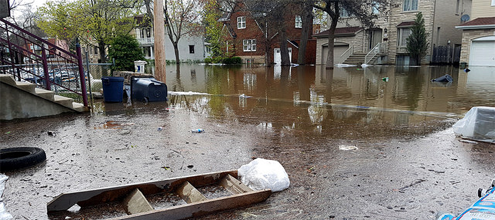
The costs of climate change are rising
Debate about reducing Canada’s greenhouse gas emissions frequently references the costs of different policy choices going forward. There is comparatively little debate about the current and expected economic costs of climate change. Policy debate and decisions need to recognize that there is a cost to doing little or nothing to curb emissions.
Real and rising costs are now being felt in two key areas: the economic and financial impact of increasingly severe weather, and the impact on public infrastructure.
Climate change is already having a significant effect on the property and casualty-insurance industry, with immediate business implications for insurers and their clients. More frequent extreme weather events have increased the level of weather-related insurance claims for floods, forest fires and other catastrophic events, globally and locally. For example, the Organization for Economic Co-operation and Development reports that annual losses from overland flooding have grown to more than US$40-billion annually in recent years; more flood events occurred in 2010-13 than in the whole decade of the 1980s.
Canadian insurers are now facing claims on natural catastrophes – floods, forest fires and other extreme weather events – of approximately $1-billion annually, according to the Insurance Bureau of Canada. This amount has grown from $400-million annually in previous decades. Claims are expected to continue to increase, as is damage to personal property and public assets. This aggregate number does not include smaller events that are not considered catastrophic (an event with total claims less than $25-million), so the full impact of climate change on Canadian insurers and clients is likely understated.
Similarly, there has been a related dramatic rise in government funding and liabilities owing to flood damage and other catastrophic events. In Canada, annual liabilities of the Disaster Financial Assistance Arrangements (DFAA) – managed by the federal and provincial governments – have risen steadily. These costs increased from around $100-million annually two decades ago to $500-million in 2009-10; they reached a current high of $2-billion in 2013-14. The Parliamentary Budget Office projected that annual DFAA liabilities would average $902-million over five years, of which $673-million would be for floods. Based on recent and repeated flooding, those estimates may prove to be conservative.
The federal government and private insurers are now engaged in discussions, along with other stakeholders, with the aim of enhancing access to affordable flood-insurance coverage for most Canadians. Improving private-sector flood-insurance coverage across Canada would help to share flood risk across many insured parties, and should presumably reduce the pressure on governments to act as the de facto flood insurer of last resort.
Future government spending on flood relief and recovery could be contained through concerted action on a combination of factors, including: better land-use planning in communities; strengthened public investment in flood mitigation, and adaptation where possible; expanded private-insurance coverage; and risk-sharing with government on insurance coverage for high-risk properties.
Another source of rising costs from climate change is public infrastructure – specifically ensuring that roads and culverts, bridges, dams, levees, sewers and drainage systems can stand up to extreme weather. Existing infrastructure will require reinforcement and new projects will need enhanced design and construction to increase their resilience to torrential rainfall, high winds and wild temperature swings.
Direct government financing, from a combination of federal, provincial and local governments, is generally seen as the first funding option for infrastructure. Canadian governments have systematically underinvested in public infrastructure for decades. The Canada Infrastructure Report Card for 2016 estimates the replacement value for existing assets deemed to be in poor or very poor condition at $141-billion. Funding will be required first to close this public infrastructure deficit, then to catch up to public expectations for new investment, and for further expansion and enhancement.
The overall availability of financing for infrastructure construction and operations will be a factor guiding that low-carbon decision-making. Newly built and retrofitted infrastructure can help to reduce future GHG emissions by utilizing low- or lower-carbon energy sources, and by making design and operational choices that help to minimize emissions. Expansion of public transit powered by low-carbon electricity – buses, streetcars, light rail, intercity rail – is an obvious example of low-carbon infrastructure investment.
Governments across Canada are engaged in trying to promote the reduction in GHG emissions at the lowest possible cost. Policy makers and the public can debate the pros and cons of the differing policy choices available; but we must also agree that there are costs to not taking action.
This piece was originally published in the Globe and Mail on May 15, 2018




Comments are closed.